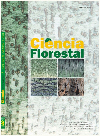
|
Ciência Florestal
Centro de Pesquisas Florestais - CEPEF, Departamento de Ciências Florestais - DCFL, Programa de Pós Graduação em Engenharia Florestal - PPGEF
ISSN: 0103-9954
EISSN: 0103-9954
Vol. 24, No. 4, 2014, pp. 807-820
|
 Bioline Code: cf14077
Bioline Code: cf14077
Full paper language: English
Document type: Research Article
Document available free of charge
|
|
|
Ciência Florestal, Vol. 24, No. 4, 2014, pp. 807-820
| en |
INFLUENCE OF URBAN FORESTS IN THE THERMO-HYGROMETRIC VARIATION IN THE INTRA-URBAN AREA OF THE CITY OF CURITIBA – PARANÁ STATE
Leal, Luciana; Biondi, Daniela & Batista, Antonio Carlos
Abstract
In order to understand the influence of urban forests in the thermo-hygrometric variation in the intra-urban
area of the city of Curitiba, this study aimed to analyze the temporal and spatial variation of temperature
and relative air humidity in each season and relate it with the presence of urban forests. For the collection
of meteorological data were established 44 monitoring points in four transects in the urban mesh. In these
points, mini-shields with Hobo® loggers were installed at fixed points on sign and traffic light posts. The
temperature and relative air humidity monitoring was conducted during periods corresponding to the four
seasons, with 22 days to collect and continuous data record at 15 minute intervals. In the four transects
analyzed in the intra-urban area of Curitiba significative differences were found between the thermohygrometric
monitoring points in all periods analyzed. Even in seasons of lower temperatures, autumn and winter, thermal differences were related to anthropogenic heat. The analysis of the longitudinal
profile of the temperature revealed a curve similar to classic profile of urban heat islands, with the highest
temperatures in more densely occupied areas and human activities, such as in the city center and southcenter
area. The lowest temperatures were found in residential districts and the suburbs, such as in the north
and northwest areas of the city and the southern city border, in addition to the evidence of the cooling effect
of urban forests present in the intra-urban area, as ‘Barigui’ and ‘São Lourenço Parks’. The regions with the
largest of permeable areas, concentration of forest remnants or public green space had lower temperatures
and increased the relative air humidity.
Keywords
urban trees; urban microclimate; air temperature
|
| |
| pt |
INFLUÊNCIA DAS FLORESTAS URBANAS NA VARIAÇÃO TERMO-HIGROMÉTRICA DA ÁREA INTRAURBANA DE CURITIBA – PR
Leal, Luciana; Biondi, Daniela & Batista, Antonio Carlos
Resumo
De modo a entender a influência das florestas urbanas na variação termo-higrométrica da área intraurbana da
cidade de Curitiba, este trabalho teve como objetivo analisar a variação temporal e espacial da temperatura
e da umidade relativa do ar em cada estação do ano e relacioná-la com a presença das florestas urbanas. Para
a coleta dos dados meteorológicos foram estabelecidos 44 pontos de monitoramento em quatro transectos
na malha urbana da cidade. Nestes pontos foram instalados miniabrigos meteorológicos com sensores
modelo Hobo®, fixados nas hastes de sinaleiros e placas de sinalização. O monitoramento da temperatura e
umidade relativa do ar foi realizado em períodos correspondentes às quatro estações do ano, com 22 dias de
coleta e registro contínuo de dados em intervalos de 15 minutos. Nos quatro transectos analisados na área
intraurbana de Curitiba foram encontradas diferenças termo-higrométricas significativas entre os pontos de
monitoramento em todos os períodos analisados. Mesmo nas estações do ano de mais baixas temperaturas,
o outono e o inverno, foram encontradas diferenças térmicas, relacionadas ao calor antropogênico. Pela
análise do perfil longitudinal das temperaturas, observou-se curva semelhante ao perfil clássico das ilhas
de calor urbano, com as maiores temperaturas nos locais com maior intensidade de ocupação e atividades
antrópicas, como na área central e região centro-sul. As menores temperaturas foram encontradas em
bairros residenciais e periféricos, como nas porções norte e noroeste do município e limite sul, além de se
evidenciar o efeito do resfriamento das florestas urbanas presentes na área intraurbana, como os Parques
Municipais Barigui e São Lourenço. As regiões com maior quantidade de áreas permeáveis, concentração
de remanescentes florestais ou espaços verdes públicos apresentaram menores temperaturas e aumento da
umidade relativa do ar.
Palavras-chave
arborização urbana; microclima urbano; temperatura do ar
|
| |
© Copyright 2014 - Ciência Florestal
Alternative site location: http://cascavel.ufsm.br/revistas/ojs-2.2.2/index.php/cienciaflorestal/index
|
|
